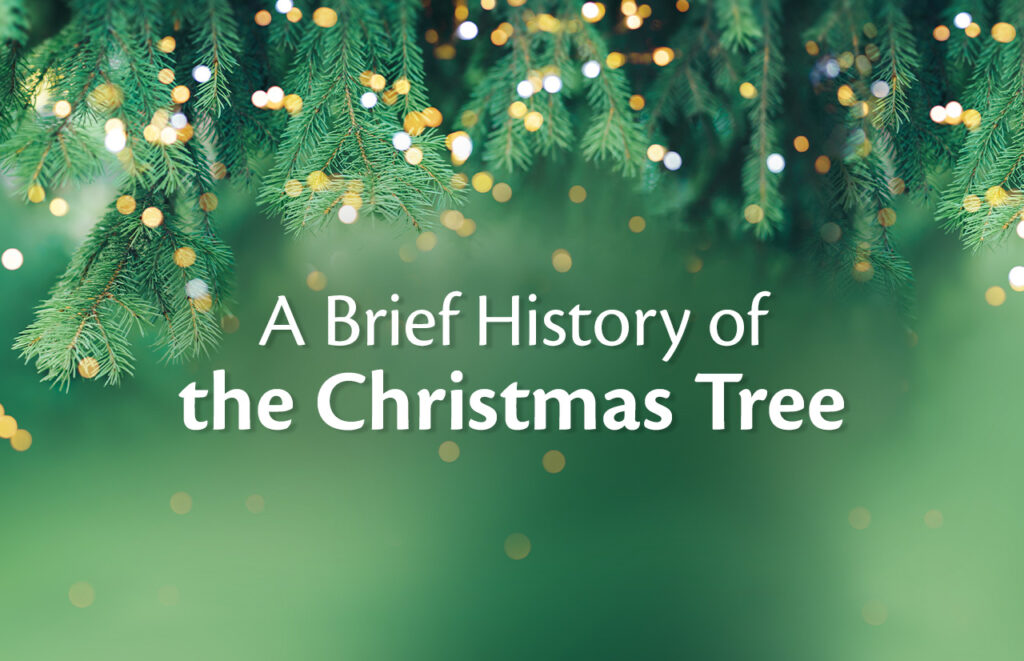If you enjoy decorating for Christmas each year, you know there is one part of the process that’s usually given a little extra attention. Some might even call it the pinnacle of the Christmas season. Whether it’s first on your “to-do” list, your final step, or even if it falls somewhere in the middle of your process, setting up the Christmas tree and decorating it is undoubtedly an important component of beautifying one’s holiday home.
But did you ever consider why the Christmas tree has become so important? Especially here in North America. There are quite a few things that have contributed to the evolution of this annual holiday tradition, but in order to get there you have to go back to the very beginning. And since Christmas 2023 is upon us, we wanted to take a closer look at the roots of the Christmas tree. That pun was most definitely intended.
The Christmas Tree Origin Story
The importance of evergreen trees (the ones most often used for holiday decorating) dates back to ancient Egypt and Rome. Because these trees retained their fresh green color most of the year, they were deemed very special. So special, in fact, that they were believed to possess the power to ward off evil spirits and to keep people protected. This even led to the worship of evergreen trees in some cultures.
As far as making these evergreen conifers into Christmas trees, Germany gets the credit. Although, this speculation is not without its controversy. There is some dispute about who started the tradition and when it first happened. Some think it was during the early 15th century when a guild in Freiburg erected a tree decorated with fruit, tinsel and cookies, while some attribute the origin to Protestant reformer Martin Luther, who supposedly decorated a Christmas tree with lit candles during the 16th century. The credit to Luther has been refuted by many history books that record the first Christmas tree appearance sometime after his death in 1546.
So, when did decorated firs, spruces and pines start showing up in North America? According to history.com, the tradition did truly migrate from Germany. The earliest record of this was in the 1830s, displayed in the Pennsylvania homes of German settlers. But by the end of the 19th century, the practice of decorating trees would grow to be hugely popular in family homes all over North America.
Christmas Tree Decorating Traditions Through the Years
The annual ritual of decorating the Christmas tree has certainly evolved since its origination. Even in just the last century, the look of the modern Christmas tree has gotten several makeovers. Let’s take a quick look at some of the key decorating differences through the last 100 years.
1910s
Christmas trees had a Victorian flair and decorating was sparse, usually relying on a handful of lit candles clipped to branches.
1920s
As you can imagine, the “Roaring ’20s” brought more flamboyance to the Christmas tree, with lots of colorful ribbons, satin balls and sparkling stars.
1930s
Marked by the Great Depression, people turned to household items and even their kitchen pantries for inspiration. This yielded decorations as diverse as those made with fabric and wood, to those that were edible. Popcorn balls come to mind.
1940s
By this time there were several U.S. companies producing Christmas ornaments, so glass bulbs of varying shape, size and color became a mainstay.
1950s
Tinsel was the crowning accent during this period, complemented by hard plastic ornaments, candy containers and illuminated figures. It is also the time that electric trains began to be incorporated into Christmas tree displays.
1960s
A more modern look was taking America by storm, defined by plastic bells, artificial trees (some of them in white) and long drapes of tinsel to create a waterfall effect.
1970s
Real trees grew in fashion again, along with the rise of something new: the Christmas village. Sculpted buildings and figurines were collected and added to holiday tree displays. You can find many just like it, available now at The Bradford Exchange.
1980s
This was the period when Christmas trees began to get a lot more eclectic. People had begun to collect ornaments and pass them down through family channels, providing more of a mismatched look, but one that held more sentimental significance.
1990s
Christmas tree decorating escalates during this time. The marketplace produced many unique themed trees, color-coordinated trees and tabletop trees to encourage multiple Christmas displays around the family home.
2000s
After the tragedy of 9/11 Christmases saw a return to freshly cut trees grown in the United States. Some even employed patriotic-themed decorating as a sign of solidarity and pride.
2010s
Welcome to the 21st century! Ten years into a new era, the rise of technology makes its way into Christmas, with color-changing LED lights, remote control gadgets and musical playlists synchronized to holiday displays.
2022
Now that we’ve arrived at Christmas 2022, we want to know how you’ll be decorating your tree this season. Tell us in the comments below. And don’t forget that The Bradford Exchange is an ideal destination for ornaments, trains, tree-toppers and yes, even Christmas trees that are not available in any stores.
Some Fun Facts About Christmas Trees
Now that we’ve covered a bit of Christmas tree history, let’s get to a few fun facts. We thought some of you might have some upcoming holiday trivia nights on your calendar. Just keep these fun facts in your back pocket. You never know when they might end up being Santa’s secret weapon.
1. Presidential Trees – every year a Christmas tree is given to the President and First Family from the National Christmas Tree Association. This is a practice that has been going on since 1966.
2. Growth – Christmas trees take an average of 7-10 years to grow to their full maturity.
3. International Decorating – if you visit Poland during the holiday season, don’t be surprised if you see Christmas trees hanging upside down from the ceiling. May seem a bit strange but it’s a practice that goes back to medieval times.
In the Ukraine, trees are decorated with spiders and spider webs, which was inspired by a regional folktale.
4. Volume – Somewhere between 25 to 30 million live Christmas trees are sold in the United States each holiday season, according to the National Christmas Tree Association. That’s a lot of trees!
5. Famous Trees – Probably the most famous Christmas tree in the world, or at least the most iconic, is the tree in Rockefeller Center in New York City. The tree has been displayed annually for over 80 years now and the lighting ceremony is considered a high point of the season for locals and tourists alike.
Other popular Christmas trees include ones on Capitol Hill in Washington D.C., Puerta del Sol in Madrid, Trafalgar Square in London, and Vilnius in Lithuania.
6. Tallest Tree – according to the Official Guinness Records, the tallest Christmas tree in the world was documented in 1950. Standing 221 feet tall, this massive Douglas fir was erected, decorated and displayed at the Northgate Shopping Center in Seattle, Washington.
7. Tinsel – one of the most consistently used Christmas tree decorations – tinsel – was banned by the government in 1972. This was due to the fact that it was originally made of lead. Once the risks of lead poisoning were identified, the manufacturing of lead tinsel ceased and plastic tinsel began to be produced.
8. Locations – Christmas trees are actually grown and harvested in all 50 U.S. states, including Alaska and Hawaii. However, the top producing states are Oregon, North Carolina, Pennsylvania, Michigan, Wisconsin and Washington, according to the National Christmas Tree Association.
Wow! That certainly put us in the holiday spirit over here. Now we’re all cozied up drinking hot cocoa and enjoying the warm glow of our enchanting and beautiful company Christmas tree. How about you? There is so much fascinating information to discover about Christmas trees once you start digging around and we had a lot of fun doing it. Thanks so much for sharing the history lesson with us. And most importantly, we would like to wish you and your family a very merry Christmas.
A Brief History of the Christmas Tree by The Bradford Exchange
